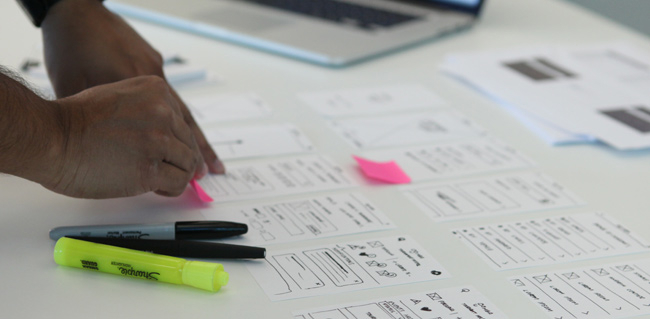Rhythm’s Guide to Prototyping

A prototype is an early model built to test a concept. Ultimately, prototypes create common understanding prior to development and lead to better final products.
At Rhythm, we produce user experience, visual, and functional prototypes as part of our work process. These kinds of prototypes let our designers and developers explore design alternatives and confirm functionality prior to starting production.
View the "Prototyping is Good For You" video:
User Experience Prototype
User experience prototyping is the process of mocking up the way a future system will work for the end user (i.e. the user’s experience). This form of prototyping generates feedback early in the process and reduces the need for changes during development.
Visual Prototype
We’ve all heard the adage that “a picture speaks a thousand words.” A visual prototype lets us do just that by acting as a visual representation of how the final product will appear.
Functional Prototype
This form of prototype often combines user experience and visual prototypes to present a functional (working) version of the future product. In the early stages of a project it can also help others understand the anticipated look and functionality.
Prototype Spectrum
The resemblance of a prototype to the final product is referred to as fidelity. At Rhythm, we create low, medium, and high fidelity prototypes at various stages of our design process.
Low Fidelity
Low fidelity prototypes are often simple sketches lacking sophisticated visuals. This level of prototyping is typically produced during brainstorming and conceptualization.
Medium Fidelity
Medium fidelity prototypes are typically produced with computer-based tools and appear more formal and refined than their low fidelity counterparts. They’re ideal for determining whether user needs are being met.
High Fidelity
High fidelity prototypes are of such quality that they’re sometimes mistaken for the final product. These prototypes can simulate the product’s functionality and are excellent for conducting usability testing.
Prototyping Do’s & Don’ts
The following are some helpful tips to keep in mind when creating prototypes:
Do’s
- Work collaboratively with users, business and IT stakeholders
- Avoid feature creep by setting expectations about the prototype’s purpose, fidelity, scope, and duration
- Remember that prototyping is a means to an end, not an end in itself
Don’ts
- Don’t prototype functionality that cannot be implemented
- Not every change or request necessarily results in a new requirement (some may be pushed to a future phase or release)
- Don’t begin a prototype review session without clear guidelines (be specific about the feedback you’re seeking)
- Don’t be a perfectionist (prototypes don’t have to be 100% perfect)
- Don’t prototype everything…you shouldn’t have to!
Looking for a pro to prototype? LET'S GET STARTED.